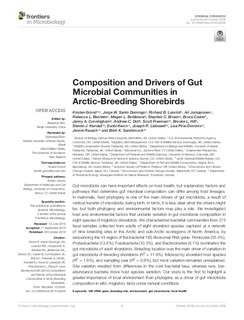| dc.contributor.author | Grond, Kirsten | |
| dc.contributor.author | Domingo, Jorge W. Santo | |
| dc.contributor.author | Lanctot, Richard B. | |
| dc.contributor.author | Jumpponen, Ari | |
| dc.contributor.author | Bentzen, Rebecca L. | |
| dc.contributor.author | Boldenow, Megan L. | |
| dc.contributor.author | Brown, Stephen C. | |
| dc.contributor.author | Casler, Bruce | |
| dc.contributor.author | Cunningham, Jenny A. | |
| dc.contributor.author | Doll, Andrew C. | |
| dc.contributor.author | Freeman, Scott | |
| dc.contributor.author | Hill, Brooke L. | |
| dc.contributor.author | Kendall, Steven J. | |
| dc.contributor.author | Kwon, Eunbi | |
| dc.contributor.author | Liebezeit, Joseph R. | |
| dc.contributor.author | Pirie-Dominix, Lisa | |
| dc.contributor.author | Rausch, Jennie | |
| dc.contributor.author | Sandercock, Brett | |
| dc.date.accessioned | 2019-10-11T10:38:32Z | |
| dc.date.available | 2019-10-11T10:38:32Z | |
| dc.date.issued | 2019 | |
| dc.identifier.issn | 1664-302X | |
| dc.identifier.uri | http://hdl.handle.net/11250/2621562 | |
| dc.description.abstract | Gut microbiota can have important effects on host health, but explanatory factors and
pathways that determine gut microbial composition can differ among host lineages.
In mammals, host phylogeny is one of the main drivers of gut microbiota, a result of
vertical transfer of microbiota during birth. In birds, it is less clear what the drivers might
be, but both phylogeny and environmental factors may play a role. We investigated
host and environmental factors that underlie variation in gut microbiota composition in
eight species of migratory shorebirds. We characterized bacterial communities from 375
fecal samples collected from adults of eight shorebird species captured at a network
of nine breeding sites in the Arctic and sub-Arctic ecoregions of North America, by
sequencing the V4 region of the bacterial 16S ribosomal RNA gene. Firmicutes (55.4%),
Proteobacteria (13.8%), Fusobacteria (10.2%), and Bacteroidetes (8.1%) dominated the
gut microbiota of adult shorebirds. Breeding location was the main driver of variation in
gut microbiota of breeding shorebirds (R2 = 11.6%), followed by shorebird host species
(R2 = 1.8%), and sampling year (R2 = 0.9%), but most variation remained unexplained.
Site variation resulted from differences in the core bacterial taxa, whereas rare, lowabundance
bacteria drove host species variation. Our study is the first to highlight a
greater importance of local environment than phylogeny as a driver of gut microbiota
composition in wild, migratory birds under natural conditions. | nb_NO |
| dc.language.iso | eng | nb_NO |
| dc.rights | Navngivelse 4.0 Internasjonal | * |
| dc.rights.uri | http://creativecommons.org/licenses/by/4.0/deed.no | * |
| dc.subject | 16S rRNA gene | nb_NO |
| dc.subject | breeding site | nb_NO |
| dc.subject | environment | nb_NO |
| dc.subject | gut microbiome | nb_NO |
| dc.subject | host health | nb_NO |
| dc.title | Composition and Drivers of Gut Microbial Communities in Arctic-Breeding Shorebirds | nb_NO |
| dc.type | Peer reviewed | nb_NO |
| dc.type | Journal article | |
| dc.description.version | publishedVersion | nb_NO |
| dc.rights.holder | © 2019 Grond, Santo Domingo, Lanctot, Jumpponen, Bentzen, Boldenow, Brown, Casler, Cunningham, Doll, Freeman, Hill, Kendall, Kwon, Liebezeit, Pirie-Dominix, Rausch and Sandercock. | nb_NO |
| dc.subject.nsi | VDP::Matematikk og Naturvitenskap: 400::Zoologiske og botaniske fag: 480 | nb_NO |
| dc.source.volume | 10 | nb_NO |
| dc.source.journal | Frontiers in Microbiology | nb_NO |
| dc.identifier.doi | 10.3389/fmicb.2019.02258 | |
| dc.identifier.cristin | 1736331 | |

